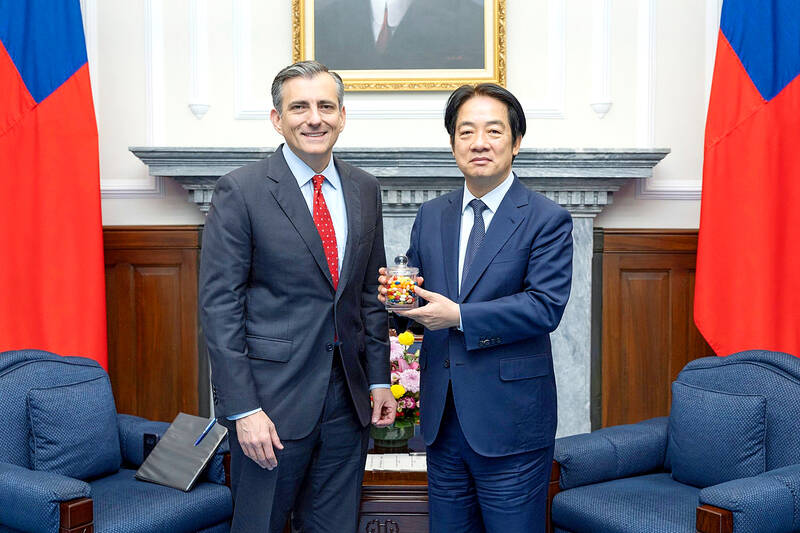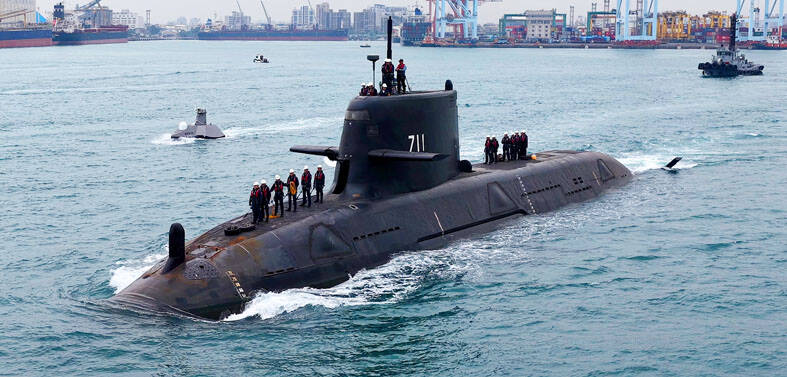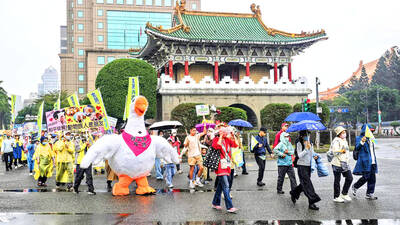Taiwan would uphold “peace through strength” when facing the expansion of authoritarianism, President William Lai (賴清德) said yesterday during a meeting with a delegation from the Ronald Reagan Presidential Foundation and Institute.
Former US president Ronald Reagan, who made the “six assurances” to Taiwan in 1982, was a good friend of Taiwan, Lai said.
“Peace through strength” is particularly important to safeguard freedom, democracy, peace and the rule-based international order in the face of authoritarian expansion, he said.

Photo courtesy of the Presidential Office
The foundation promotes personal freedom, economic opportunity, global democracy and national dignity, he said, expressing hope that Taiwan and the US would continue to deepen bilateral ties.
Lai also vowed to implement his “Four Pillars of Peace” action plan to strengthen national defense capability and economic security while demonstrating leadership regarding cross-strait relations.
Taiwan would promote value diplomacy and deepen cooperation with the US and other democratic countries to ensure regional peace and stability, and to safeguard democracy and freedom, he added.
Freedom is a universal right that no one should be deprived of, foundation president David Trulio said.
“Taiwan’s open society and thriving democracy make the commitment to freedom here plain for all to see,” he said.
Maintaining peace through strength is crucial in cross-strait relations, and it includes a strong partnership between the US and Taiwan, and the US’ sustained deterrence, Trulio said.
After the foundation’s last visit in October 2023 during the administration of former president Tsai Ing-wen (蔡英文), the latest visit is crucial, as the new US administration is to be inaugurated in 10 days, Trulio added.
“It has been plain to see that Taiwan stands strong as a vibrant democracy, with political parties sharing a commitment to democratic principles,” he said. “It is also plain to see that Taiwan’s advanced economy and global technological leadership present positive opportunities for the US.”
Trulio expressed hope that the two countries would continue to deepen their shared commitment to freedom, democracy, economy, security and stability.

NUMBERS IMBALANCE: More than 4 million Taiwanese have visited China this year, while only about half a million Chinese have visited here Beijing has yet to respond to Taiwan’s requests for negotiation over matters related to the recovery of cross-strait tourism, the Tourism Administration said yesterday. Taiwan’s tourism authority issued the statement after Chinese-language daily the China Times reported yesterday that the government’s policy of banning group tours to China does not stop Taiwanese from visiting the country. As of October, more than 4.2 million had traveled to China this year, exceeding last year. Beijing estimated the number of Taiwanese tourists in China could reach 4.5 million this year. By contrast, only 500,000 Chinese tourists are expected in Taiwan, the report said. The report

Temperatures are forecast to drop steadily as a continental cold air mass moves across Taiwan, with some areas also likely to see heavy rainfall, the Central Weather Administration (CWA) said. From today through early tomorrow, a cold air mass would keep temperatures low across central and northern Taiwan, and the eastern half of Taiwan proper, with isolated brief showers forecast along Keelung’s north coast, Taipei and New Taipei City’s mountainous areas and eastern Taiwan, it said. Lows of 11°C to 15°C are forecast in central and northern Taiwan, Yilan County, and the outlying Kinmen and Lienchiang (Matsu) counties, and 14°C to 17°C

STEERING FAILURE: The first boat of its class is experiencing teething issues as it readies for acceptance by the navy, according to a recent story about rudder failure The Hai Kun (海鯤), the nation’s first locally built submarine, allegedly suffered a total failure of stern hydraulic systems during the second round of sea acceptance trials on June 26, and sailors were forced to manually operate the X-rudder to turn the submarine and return to port, news Web site Mirror Daily reported yesterday. The report said that tugboats following the Hai Kun assisted the submarine in avoiding collisions with other ships due to the X-rudder malfunctioning. At the time of the report, the submarine had completed its trials and was scheduled to begin diving and surfacing tests in shallow areas. The X-rudder,

DEMAND: The government should enact regulations in line with Austria and Germany to incorporate vegan nutrition into school meals, an advocate said More than 1,000 people yesterday marched in Taipei to promote veganism, calling for legislation to incorporate vegan diets into school lunches and the national net zero emissions program. Participants gathered on Ketagalan Boulevard in front of the Presidential Office Building for the march, which was organized by the Vegan Action Network (VAN). Former ambassador to Chad Chiu Chung-jen (邱仲仁), actor Yankee Yang (楊子儀) and actress Cindy Lien (連俞涵) attended the event. VAN member Marianne Chao (趙梅君) said that the campaign aimed to urge the government to promote vegan diets across schools and government agencies via legislation and national policies, which would help build